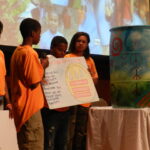Environmental Action Civics was developed by Earth Force to engage young people as active citizens who address environmental issues in their communities, both now and in the future. It is a research-based approach that focuses on project-based learning and civic action to empower students to identify environmental problems, investigate their root causes, and design and implement solutions through civics. Through this process, students develop important civic skills that will help them make a real impact in their communities, particularly those that have been historically marginalized.
Environmental Action Civics embodies the belief that participation in local environmental decision-making is critical to equitable processes, innovative solutions, and enduring democratic and civic skills. It gives more people a voice in local environmental decision-making, particularly youth who are likely to bring fresh perspectives to problems. It also helps young people build a civic toolkit to solve problems as they develop a sense of social responsibility that fosters environmental stewardship and community engagement.
Each year, Earth Force works with approximately 67 schools and organizations in 28 states to engage students in Environmental Action Civics. Earth Force offers resources, professional development, consulting, and a community of practice for schools and organizations interested in implementing the model. What is Environmental Action Civics? Young People Reflect on Community Resilience to Natural Hazards Environmental Action Civics Overview
What Makes This Model Innovative?
Relevance
Social Consciousness & Action
Connection & Community
Goals
The goals of Environmental Action Civics embody the belief that participation in local environmental decision-making is critical to equitable processes, innovative solutions, and enduring democratic and civic skills.
Citizenship
Students build democratic skills like discussion, deliberation, and debate to engage policymakers and advocate for environmental issues in their local community.
Research
Students conduct qualitative and quantitative research to collect information in their community that helps them identify the root causes of environmental problems.
Problem-Solving
Students develop equity-focused action plans to address environmental issues using a civic toolkit, research, and fresh perspectives.
Environmentalism
Students learn to be active stewards of the natural world by advocating for policies that enhance ecosystem resilience and well-being.
Experience
 Earth Force uses a research-based process to guide students through Environmental Action Civics. The process engages students in Civic Action Projects to meet an environmental need in their local community. Projects are typically completed in small groups where democratic processes such as discussion, deliberation, debate, and voting are used to make decisions. Peer accountability measures ensure that individual students are responsible for tasks throughout projects.
Earth Force uses a research-based process to guide students through Environmental Action Civics. The process engages students in Civic Action Projects to meet an environmental need in their local community. Projects are typically completed in small groups where democratic processes such as discussion, deliberation, debate, and voting are used to make decisions. Peer accountability measures ensure that individual students are responsible for tasks throughout projects.
During projects, students focus on advocacy for systemic changes to environmental policies and practices as they work through a series of six steps to design and complete projects that will teach them widely transferable skills. Environmental Action Civics Roadmap
Students begin their projects by conducting an environmental inventory to identify environmental strengths and concerns. The inventory can take several forms: a survey, a walking tour of the school grounds, an energy use audit, demographic data to identify inequities, or other tools. They develop an awareness of the roles played by an environmental citizen and of the importance of taking public action in their community. This step of the process allows students to learn about the environment in the context of their own identities and lived experiences. Step 1: Community Environmental Inventories Inventory: Keys to Success

During this step of the process, as a group, students select a single issue as the focus of their project. Students use criteria-based, democratic decision-making to work with peers, teachers, and community members as they refine the topic that they will research and study. Environmental Action Civics projects have unique relevance as they allow students to select an issue they are excited about while also supporting teacher academic goals. Step 2: Issue Selection What’s For Lunch – An Example of Criteria-Based Decision-Making
As students conduct research for their projects, they develop a more holistic understanding by exploring policies and practices related to their issue. They seek to identify the root causes of their issue by:
- using questioning and information analysis skills,
- identifying and interacting with stakeholders and experts,
- exploring different perspectives, and
- discovering strategies for change.
Students also engage three or more community members (including those impacted by the issue) to better understand their issue and inform an equitable and impactful action plan. Step 3: Policy and Community Practice Research Examples of Policies & Practices
Students use democratic and criteria-based decision-making to select one policy or practice they want to change. They also select the most appropriate strategy to achieve the desired change based on what they have learned from local stakeholders in their community. The student-led discussions in this stage of a project are evidence-based and contextualize how students understand the issue they are working on. These take place in the classroom or learning space with the educator supporting the process. Step 4: Goal and Strategy Selection Strategy Selection Grid Examples and Inspiration of Strategies for Your Change
 Students collaboratively create an action plan for the change they seek to make in their community. Because they are focused on long-term solutions that address the root causes of the problem they want to solve, they engage people in positions of power and partner with adults and allies to advocate for solutions. Step 5: Taking Action! Action Planning Sheet
Students collaboratively create an action plan for the change they seek to make in their community. Because they are focused on long-term solutions that address the root causes of the problem they want to solve, they engage people in positions of power and partner with adults and allies to advocate for solutions. Step 5: Taking Action! Action Planning Sheet
 Students use prompts to review their learning experience by recognizing their successes, analyzing challenges, reflecting on lessons learned, and identifying potential next steps for their projects. These written reflections inform the students’ public presentations, through which they share their work with peers, stakeholders, and supporters. Finally, they submit their project story to Earth Force where it is celebrated and shared more widely. Step 6: Celebration and Reflection Reflection Prompts and Methods
Students use prompts to review their learning experience by recognizing their successes, analyzing challenges, reflecting on lessons learned, and identifying potential next steps for their projects. These written reflections inform the students’ public presentations, through which they share their work with peers, stakeholders, and supporters. Finally, they submit their project story to Earth Force where it is celebrated and shared more widely. Step 6: Celebration and Reflection Reflection Prompts and Methods
Supporting Structures
The following shifts in school structures support the implementation of the Environmental Action Civics model. Because the model is highly adaptable, there is flexibility in how it can be adopted.
Environmental Action Civics is built upon six steps that are sequenced to help students grow as environmental citizens.
Environmental Action Civics emphasizes process rather than product to foster skills and empowerment for students. The model can be adapted into any curriculum but must include three key experiences to be adopted with fidelity: (1) working in a youth-adult partnership to select the environmental issue the young people want to work on; (2) deliberating relevant policies and community practices; and (3) asking for a change from someone in power. The scaffolding within the steps ensures that Civic Action Projects can be aligned with curricular goals in different classes and within different time frames.
Environmental Action Civics is accessible by any age group, although Earth Force materials are generally geared toward middle and high school students. It is particularly suited to schools that practice project-based and inquiry-based learning. The model is most commonly incorporated into social studies and science courses, although it has also been adopted in after-school programming.
The process at the center of Environmental Action Civics inspires participation in real-world, local problem-solving working side-by-side with adults. The quality of Environmental Action Civics is measured by the Roadmap rather than any specific assessment. Environmental Action Civics Roadmap The process also aligns with Next Generation Science Standards and College, Career, and Civic Life Framework for Social Studies State Standards. Earth Force Align & Plan
The Environmental Action Civics model relies on a community and culture that supports student voice and civic engagement.
A central element of Environmental Action Civics is a commitment to prepare young people, especially those from historically marginalized communities, to engage in local decision-making processes that impact the environment. Schools adopting the model must be open to encouraging student voice and be prepared to support students who are working for change in their community.
To cultivate the agency that students need in their action civics projects, adults must share power and let students assume full responsibility for their work.
Because Environmental Action Civics seeks to encourage active citizenship in students, teachers must be willing to step aside and let students work through established processes to develop and complete their projects. This means that adults guide students toward learning rather than direct them to answers. Adults serve as learning partners who let students work through processes to practice professional and personal skills that will carry long-term value in life.
Environmental Action Civics is designed to be incorporated into any schedule.
The Environmental Action Civics model can be adapted to different lengths of time depending on school or teacher needs. It could be used as the framework for a semester-long course or as a multi-week project in a specific class or program. Although the time commitment can vary, a minimum of 10 hours is likely needed to complete the six steps of a Civic Action Project at the most basic level.
Partnerships in the local community enhance the opportunities for impact that students have in Civic Action Projects.
As a part of their civic action projects, students must reach out to members of their local community. Partnerships can help students develop more powerful projects by giving them access to more diverse stakeholders as well as people in positions of power in their community. Although the level of engagement of community members will vary, partnerships are an important part of the learning process because they represent a portion of the public attitude toward the environment.
Schools adopting Environment Action Civics will need to commit time and energy to the cultivation of partnerships. In general, community partners are very willing to work with youth and schools, and being able to make virtual connections has made partnership development even easier.
Environmental Action Civics is built upon six steps that are sequenced to help students grow as environmental citizens.
Environmental Action Civics emphasizes process rather than product to foster skills and empowerment for students. The model can be adapted into any curriculum but must include three key experiences to be adopted with fidelity: (1) working in a youth-adult partnership to select the environmental issue the young people want to work on; (2) deliberating relevant policies and community practices; and (3) asking for a change from someone in power. The scaffolding within the steps ensures that Civic Action Projects can be aligned with curricular goals in different classes and within different time frames.
Environmental Action Civics is accessible by any age group, although Earth Force materials are generally geared toward middle and high school students. It is particularly suited to schools that practice project-based and inquiry-based learning. The model is most commonly incorporated into social studies and science courses, although it has also been adopted in after-school programming.
The process at the center of Environmental Action Civics inspires participation in real-world, local problem-solving working side-by-side with adults. The quality of Environmental Action Civics is measured by the Roadmap rather than any specific assessment. Environmental Action Civics Roadmap The process also aligns with Next Generation Science Standards and College, Career, and Civic Life Framework for Social Studies State Standards. Earth Force Align & Plan
The Environmental Action Civics model relies on a community and culture that supports student voice and civic engagement.
A central element of Environmental Action Civics is a commitment to prepare young people, especially those from historically marginalized communities, to engage in local decision-making processes that impact the environment. Schools adopting the model must be open to encouraging student voice and be prepared to support students who are working for change in their community.
To cultivate the agency that students need in their action civics projects, adults must share power and let students assume full responsibility for their work.
Because Environmental Action Civics seeks to encourage active citizenship in students, teachers must be willing to step aside and let students work through established processes to develop and complete their projects. This means that adults guide students toward learning rather than direct them to answers. Adults serve as learning partners who let students work through processes to practice professional and personal skills that will carry long-term value in life.
Environmental Action Civics is designed to be incorporated into any schedule.
The Environmental Action Civics model can be adapted to different lengths of time depending on school or teacher needs. It could be used as the framework for a semester-long course or as a multi-week project in a specific class or program. Although the time commitment can vary, a minimum of 10 hours is likely needed to complete the six steps of a Civic Action Project at the most basic level.
Partnerships in the local community enhance the opportunities for impact that students have in Civic Action Projects.
As a part of their civic action projects, students must reach out to members of their local community. Partnerships can help students develop more powerful projects by giving them access to more diverse stakeholders as well as people in positions of power in their community. Although the level of engagement of community members will vary, partnerships are an important part of the learning process because they represent a portion of the public attitude toward the environment.
Schools adopting Environment Action Civics will need to commit time and energy to the cultivation of partnerships. In general, community partners are very willing to work with youth and schools, and being able to make virtual connections has made partnership development even easier.
Supports Offered
Earth Force offers the following supports to help implement Environmental Action Civics.
Earth Force Resources
Free
Schools that want to implement Environmental Action Civics can access extensive resources. Resources are organized around each of the six steps that structure the model.
Register for a free account to access Earth Force resources.
Professional Development
Cost Associated, Free
Earth Force provides different types of professional development and support for schools and districts:
- Educator Workshops
- Organization Workshops
- Ongoing Supports
- Community Forums
- Community of Practice (Coming Soon)
Custom workshops are also available for a fee.
Reach
Impact
Evaluations by Brandeis University’s Center for Youth & Communities over the past 18 years have found that Environmental Action Civics strengthens student civic commitment and participation and increases their sense of efficacy. Environmental Action Civics History & Impact
- 91% of students met with school or community leaders to ask them to take action.
- 84% of students show an increase in understanding of environmental issues.
- 77% of students are more likely to contact a public official to advocate for action on an environmental issue in the future.
Educators also reported that the Environmental Action Civics program positively impacted their teaching by increasing their knowledge of environmental issues and expanding their use of community issues and student-led projects in their classrooms:
- 70% of educators noted an increased sense of self-confidence as an educator.
- 91% of educators stated that Environmental Action Civics increased their students’ belief that they can make a difference in the community.



